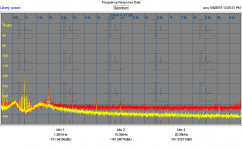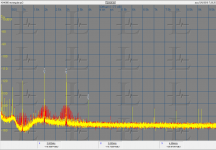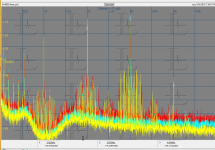Better comparison between Victor w/ fresh batteries and the ULD4. Red is the ULD4 and Yellow is the Victor oscillator. I have some annoying common mode power stuff I need to sort out between the various boxes. Even adding a ground from the Victor (running on batteries) to the different ground options on the 725 adds a lot of junk. On the ULD4 there is some crosstalk from the 10 KHz and the 20 KHz even when they are all the way down. All the oscillators are always running. Andreas will be looking into this. But my 725 has some issues as well. I still need to implement more of Davida's revisions.
The ULD is running from a small wall wart and its internal DC-DC converter. The isolation is very high and noise from the converter is quite low. I will need to learn more about it.
The ULD is running from a small wall wart and its internal DC-DC converter. The isolation is very high and noise from the converter is quite low. I will need to learn more about it.
Attachments
Richard I thought you making a general statement about averaging in FFT.
I have no experience with any AP product but looking at what you put up there it looks more like you changed the number of points rather than the averaging. But I guessing it's clearly marked in the AP configuration.
I have no experience with any AP product but looking at what you put up there it looks more like you changed the number of points rather than the averaging. But I guessing it's clearly marked in the AP configuration.
Demian I hope you stash LME49990. They are really useful for the Shibasoku 725.
I wish I bought more before they went out of production.
Just looked at Digikey. It looks there are still some available by special order.
I wish I bought more before they went out of production.
Just looked at Digikey. It looks there are still some available by special order.
Last edited:
Did Victors go lower in thd in later versions? Mine doesnt do as well as Demian's.
Is scaling correct? I measure same for 2H but 3H is much lower on yours'.
Damian.... today, I found a new Liberty Instruments Praxis black box and you can have it as back up for the one you like to use.
yes? no?
-RM
Is scaling correct? I measure same for 2H but 3H is much lower on yours'.
Damian.... today, I found a new Liberty Instruments Praxis black box and you can have it as back up for the one you like to use.
yes? no?
-RM
Last edited:
Re praxis. YES!Did Victors go lower in thd in later versions? Mine doesnt do as well as Demian's.
Is scaling correct? I measure same for 2H but 3H is much lower on yours'.
Damian.... today, I found a new Liberty Instruments Praxis black box and you can have it as back up for the one you like to use.
yes? no?
-RM
My Victor oscillator is first Gen. The current ones are better. The linearity of the load is critical with a 600 Ohm source.
Sent from my SGH-M919 using Tapatalk
Did Victors go lower in thd in later versions? Mine doesnt do as well as Demian's.
Is scaling correct? I measure same for 2H but 3H is much lower on yours'.
Damian.... today, I found a new Liberty Instruments Praxis black box and you can have it as back up for the one you like to use.
yes? no?
-RM
One thing I noticed is the window was in hann on QA. You prefer flat top. Mine jumped a few dB switching to flat top.
I can't get the QA to cal with the newer software. The gen output is 0.649dBV when it should be 0dBV and the the 400 won't cal no matter what. I can't go back to earlier sw because I running win10 now.
Here is the typical spectrum of the last 1kHz boards (The scale is properly adjusted on 3kHz, but 2kHz needs +4dB):

In the previous generation examples the main problem was the distortions injection from the AGC detector via the parasitic capacitances across the board. The last boards have the Schottky dual diode in SOT23 package instead of the two LL4148 diodes in the detector's schematic. Also the detector has some other changes in the schematic and the topology for to minimize the distortions injection. Maybe the small shield over the AGC detector region can help to get little better performance from the previous boards. That shield is used in the 10kHz generators:
http://content32-foto.inbox.lv/albums/e/elterra/10kHz/10kHz.jpg
Victor.

In the previous generation examples the main problem was the distortions injection from the AGC detector via the parasitic capacitances across the board. The last boards have the Schottky dual diode in SOT23 package instead of the two LL4148 diodes in the detector's schematic. Also the detector has some other changes in the schematic and the topology for to minimize the distortions injection. Maybe the small shield over the AGC detector region can help to get little better performance from the previous boards. That shield is used in the 10kHz generators:
http://content32-foto.inbox.lv/albums/e/elterra/10kHz/10kHz.jpg
Victor.
One thing I noticed is the window was in hann on QA. You prefer flat top. Mine jumped a few dB switching to flat top.
I can't get the QA to cal with the newer software. The gen output is 0.649dBV when it should be 0dBV and the the 400 won't cal no matter what. I can't go back to earlier sw because I running win10 now.
I noticed that there was no working cal function on the QA401. The older QA400 software worked fine on Win 10 for me.
Finding a suitable window function is more complex depending on what you are looking for. Flat top is good for measuring amplitudes of discrete spectral lines but will have sideband artifacts and is not good for looking at what is hiding in the noise. The Hodie7 window I used for the plots above does a good job of unearthing stuff in the noise but may not have the most accurate level on the peaks if they are not perfectly in a bin.
Below are some overlaid spectra. they are all the same source with different windowing. And different results. Praxis has 9 window options. I don't know enough how to select with confidence. The first plot is a rectangular window over a Bingham window. The Bingham window has the sidebands that the rectangular window doesn't in this measurement. The second is three overlaid and you can see the different levels of the peaks.
With analog sources and high resolution plots its essentially impossible to get the signals perfectly in a bin. How the window handles the beginning and end of the measurement influences the sidebands and the low level stuff.
Attachments
Which is why, with the Shibasoku, I just read the meter. The FFT is a nice graphical display and good for relative measures.
Demian I hope you stash LME49990. They are really useful for the Shibasoku 725.
I wish I bought more before they went out of production.
Just looked at Digikey. It looks there are still some available by special order.
Newark still has them, 129 in stock:
http://www.newark.com/texas-instruments/lme49990ma-nopb/op-amp-110mhz-22v-us-soic-8/dp/71R5091/false
Thanks.
evil windows
DiAna doesn't need a window at all. 😀[...]
Finding a suitable window function is more complex depending on what you are looking for.
[...]
119 in stock now...
-RNM
I had bought 25 even before the the last quote.
DiAna doesn't need a window at all. 😀
Okay so where is it?
As DiAna is a distortion analyzer instead of just another spectrum analyzer. The spectrum it shows is derived from the residual, which in turn is the result of averaging a large number of cycles and subtracting the fundamental. Apart from averaging, it just works like an analog distortion analyzer (e.g. a HP333A), though in this case in the digital domain. It boils down that all data processing (avaraging) has been done before the FFT is calculated, hence no window, zero padding or whatsoever. Leakage is very low: from the fundamental ca. -400dB and from harmonics ca. -200dB.And why not?
Do you mean (a link to) a full description of DiAna? Not yet, as I'm busy with other things at the moment.Can you post a link?
Cheers, E.
For some screen shots see: Lynx-L22 sucks in single ended mode. - Lynx Support ForumOkay so where is it?
and http://www.diyaudio.com/forums/equi...n-audio-range-oscillator-459.html#post4697372
This program is not yet available for several reasons:
1. I'm not sure whether I should offer it as a commercial product or as shareware.
(My GF still dreams that I'm becoming a rich man with it, but don't care that much about money.)
2. It's still not finished. The interface box for differential measurements must be rebuilt and a help file as well as documentation must be written.
3. To add insult to injury, I'm moving for a relocation.
Anyway, the most easy way is to ask a voluntary contribution and in order to combat widespread illegal copying, to watermark each copy with name and address (or security number for that matter 😉 ) Remember, I've invest a huge amount of time (10000 hours) in DiAna. So I'm reluctant to completely give it away for free.
What do you guys think I should do?
Cheers, E.
For some screen shots see: Lynx-L22 sucks in single ended mode. - Lynx Support Forum
and http://www.diyaudio.com/forums/equi...n-audio-range-oscillator-459.html#post4697372
This program is not yet available for several reasons:
1. I'm not sure whether I should offer it as a commercial product or as shareware.
(My GF still dreams that I'm becoming a rich man with it, but don't care that much about money.)
2. It's still not finished. The interface box for differential measurements must be rebuilt and a help file as well as documentation must be written.
3. To add insult to injury, I'm moving for a relocation.
Anyway, the most easy way is to ask a voluntary contribution and in order to combat widespread illegal copying, to watermark each copy with name and address (or security number for that matter 😉 ) Remember, I've invest a huge amount of time (10000 hours) in DiAna. So I'm reluctant to completely give it away for free.
What do you guys think I should do?
Cheers, E.
What you describe absolutely cannot work. No way. You must prove it to me by sending me a free copy! 🙂 (Gotcha!)
Sell it. Or find investors in crowd funding to allow patents on whatever you can patent. Then give the crowd copies and sell more.
Hi Edmond,
I think that shareware might be the way to go. You should profit from your work, but not so much as to have it ripped off. That would mean you get paid for some, but not the huge majority. Paying kills nag screens and maybe unlocks some features.
Does that like a road you would like to take?
-Chris
I think that shareware might be the way to go. You should profit from your work, but not so much as to have it ripped off. That would mean you get paid for some, but not the huge majority. Paying kills nag screens and maybe unlocks some features.
Does that like a road you would like to take?
-Chris
- Home
- Design & Build
- Equipment & Tools
- Low-distortion Audio-range Oscillator


